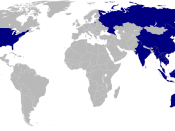A few decades of economic growth that has been inducing praise for their seemingly longest period of sustained growth ever contributed. The conjecture suggested that there is an "Asian century" ahead, and that East Asia's economies would overthrow the world economic leadership of the United States and other incumbents in the field of the world economy like Europe. Prospects for gaining a position in the world economic ranking at least next to the main players seemed plausible. One of the theories that try to explain rising Asian Tigers and rising Japan is the flying geese model. The flying geese model can be visualised as a troop of geese, with one flying at head-position and the others following its lead. Each country began by manufacturing and exporting simple, labour intensive products like garments, shoes and assembly of low-end products. As it accumulated more capital and know-how, it moved through products of intermediate complexity, and then to high-value added products and services.
As one country moved on to the next level of value added, another developing country would take its place as at the lower-value end. Japan led the flock, followed by Hong Kong, Singapore, South Korea and Taiwan. Then came China, Malaysia, Thailand, the Philippines, Indonesia, and Vietnam in the tail. These countries were admired for overcoming the so-called "barriers to late industrialisation" and were used as models for other developing countries. The flying geese model argues that Japanese companies indeed started a series of successful product and process innovations and spread these innovations from developed East Asian countries to less developed Southeast Asian countries. This concept of national geese flying in formation shaped the pattern of what diversified Asian-owned companies invested in next and where multinationals located their activities in Asia.
Akamatsu (1962) and Kojima (1978) described the "catching-up product...


